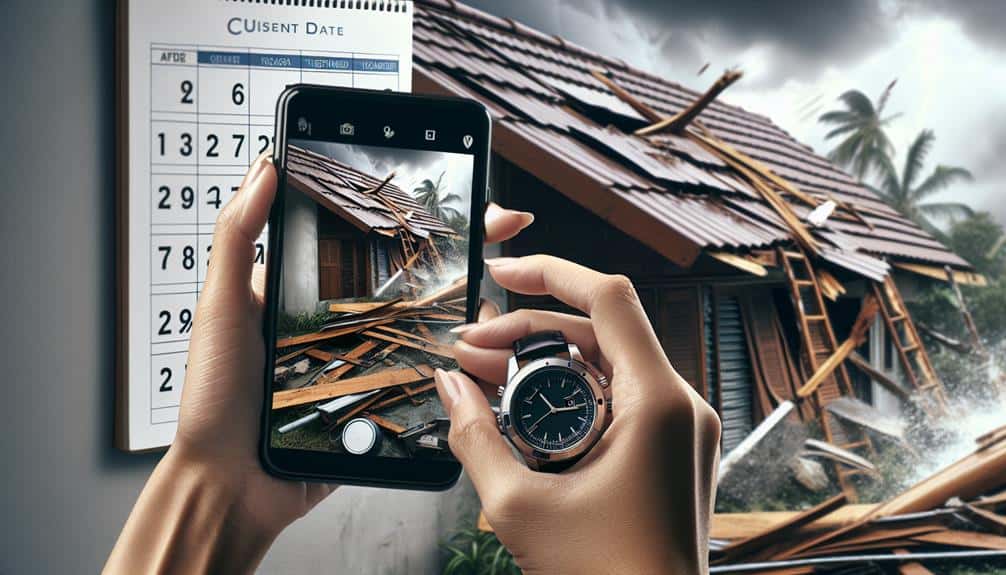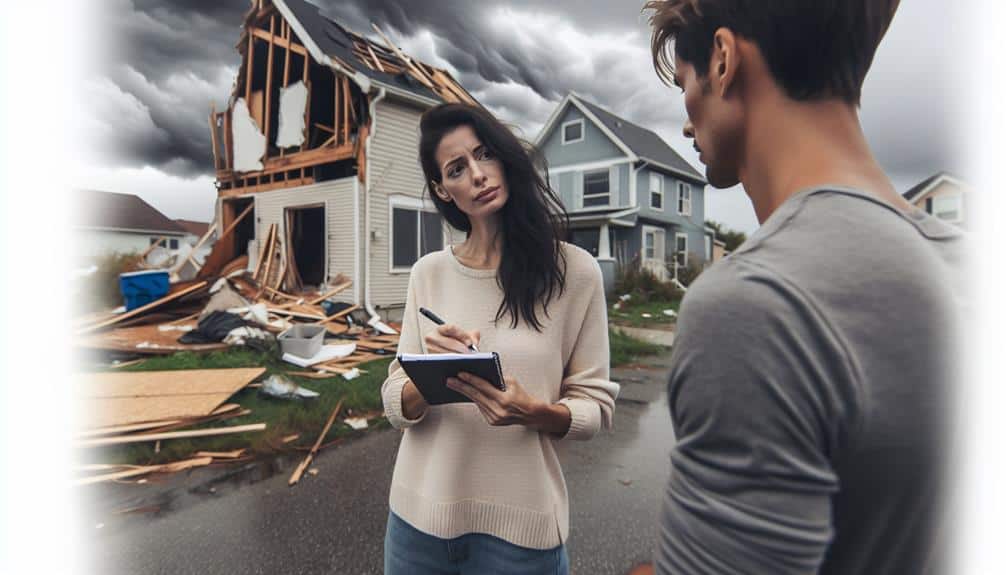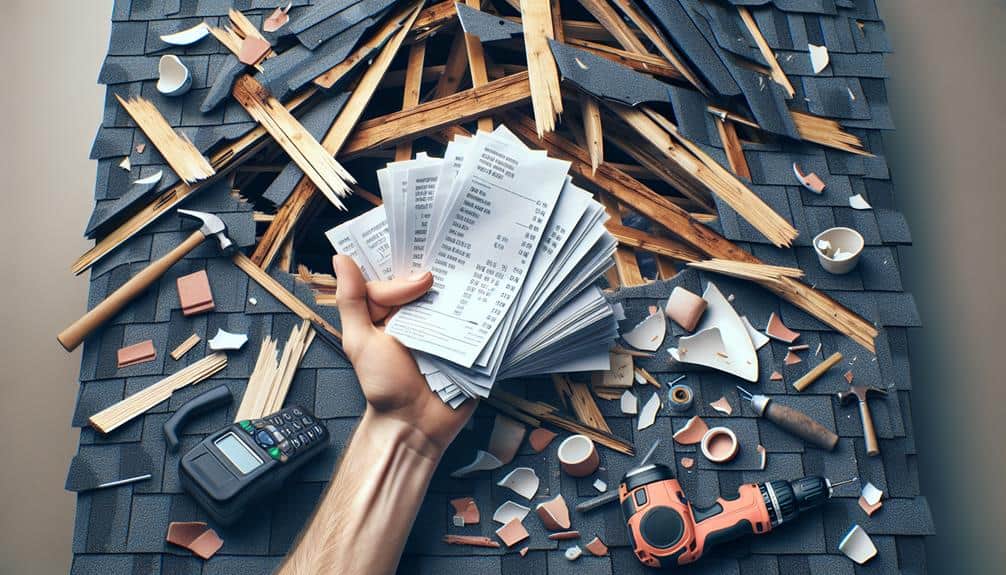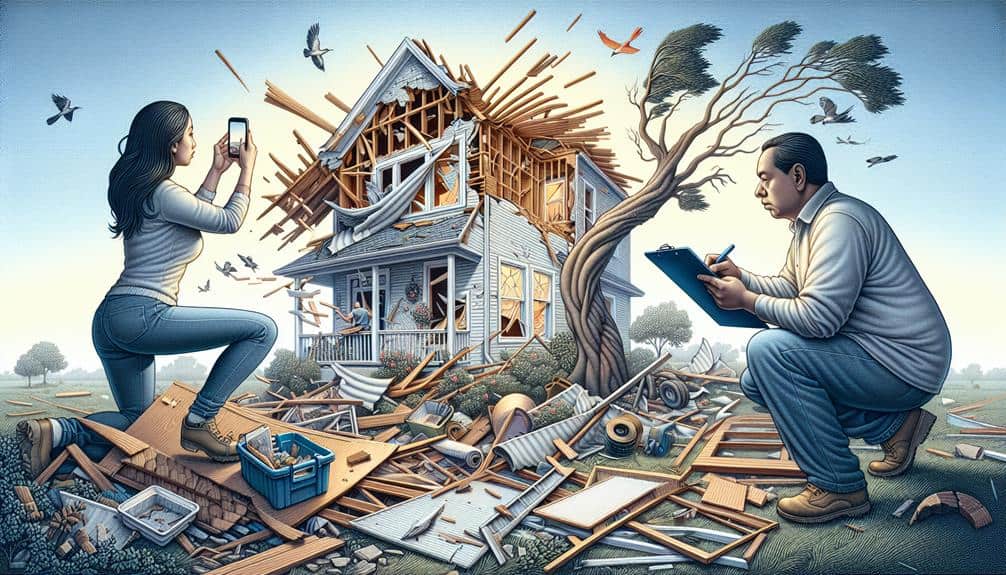We emphasize a systematic approach to documenting storm damage for effective roof repair and insurance claims. First, we thoroughly inspect the roof, focusing on worn and displaced materials and structural stress. We capture clear, high-definition photos, using drones for panoramic views. We note the date, time, and weather conditions, employing apps and weather stations for precise data. Witness statements from neighbors support our findings, adding professional contractor insights as needed. Detailed repair estimates, including itemized costs and contractor credentials, guarantee transparency. Keeping all receipts is essential for accurate reimbursement. Follow these steps to streamline the repair process and guarantee maximum claim success.
Key Points
- Thoroughly inspect the roof for visible wear, cracks, or displacement, focusing on vulnerable areas.
- Capture clear wide-angle and close-up photos of damaged areas, ensuring date and time stamps for documentation.
- Record detailed weather conditions during and after the storm using weather apps, websites, or localized weather stations.
- Collect witness statements from neighbors and roofing professionals to validate the storm's impact and timeline.
Inspect the Roof Thoroughly
Before initiating any roof repair, we must conduct a thorough inspection to identify all areas affected by storm damage. This initial step is important to make sure that we address all potential issues and prevent future complications. Our primary focus during the inspection is to assess the roofing materials and evaluate the structural integrity of the roof.
First, we systematically examine the roofing materials. This includes checking shingles, tiles, or metal panels for signs of wear, cracks, or displacement caused by high winds or hail. Special attention is given to any areas where the roofing materials overlap or connect, as these are common points of failure during severe weather.
Next, we turn our attention to the structural integrity of the roof. We inspect the underlying support structures, such as rafters and trusses, for any signs of stress, warping, or water damage. This step makes sure that the roof can continue to bear loads and remain stable.
Photograph All Damage
When we photograph all damage, we should capture clear wide shots of the entire roof and surrounding areas.
It's important to highlight specific damaged sections in close-up photos to provide detailed evidence.
Additionally, we must make sure each photo includes a timestamp to verify the date and time of the damage.
Capture Clear Wide Shots
Why is it significant to capture clear expansive shots when documenting storm damage to a roof? Wide shots offer an overarching perspective that's vital for a thorough evaluation. By utilizing aerial drones, we can obtain panoramic views that display the full extent of the damage. This bird's-eye view captures the spatial context, aiding in understanding how different areas of the roof are interconnected and affected.
A clear wide shot serves as a foundational reference point. When we later take detailed close-ups, these wide shots offer a frame of reference for the specific areas being examined. This is essential for creating a coherent narrative of the damage, facilitating both the repair planning and insurance claim processes. For instance, wide shots make before-after comparisons more effective, enabling us to document the roof's condition pre- and post-repair comprehensively.
Furthermore, wide shots help identify potential secondary issues that mightn't be immediately apparent in detailed close-ups. The broader perspective ensures we don't overlook any significant elements, guaranteeing a thorough documentation process.
For an audience that values freedom, this meticulous approach provides the reassurance and transparency needed to make informed decisions confidently.
Highlight Specific Damaged Areas
Having established a detailed overview with wide shots, we now focus on capturing detailed photographs of specific damaged areas to make certain each issue is meticulously documented. High-resolution images are invaluable when evaluating damage to roof shingles, gutters, chimneys, and skylights, providing a thorough basis for repair estimates.
First, we inspect the roof shingles. Look for missing or broken shingles, and photograph each individual instance. Close-up shots should clearly show cracks, edges, and any granule loss. This level of detail helps in understanding the extent of damage and planning for precise repairs.
Next, we turn our attention to the gutters. Document any dents, rust spots, or sections where gutters have detached from the roofline. The images should show the full length of the damaged areas, as well as close-ups of any specific issues.
For the chimney, we must photograph any loose or missing bricks, cracks in the mortar, and signs of water intrusion. Make sure the images capture both the base and the top of the chimney.
Lastly, focus on the skylight. Document any cracks, leaks, or damaged seals. Clear photos of the affected areas will assist in determining whether a repair or replacement is necessary.
Include Date and Time
To guarantee detailed documentation, we must include the date and time on each photograph to provide an accurate timeline of the storm damage. This practice is important for validating the sequence of events and making sure that our records are accurate and reliable.
Time-stamped photos allow us to present undeniable evidence to insurance adjusters or contractors, thereby streamlining the claims process.
By making sure our photos are time-stamped, we add a layer of credibility to our documentation. Here's why date and time are significant:
- Verification: Time-stamped images verify when the damage occurred, eliminating any disputes about the timeline.
- Accuracy: They provide clear chronological order, which is crucial for evaluating the progression of the damage.
- Claims Process: Insurance companies often require precise documentation; time stamps help meet these requirements.
We should use smartphones or cameras with built-in timestamp functionalities to capture these images. By doing this, we ensure that our photographic evidence isn't just comprehensive but also legally robust, giving us the freedom to navigate the repair process efficiently.
Note the Date and Time

We must record the exact date and time of the storm damage to guarantee our documentation is accurate and verifiable. Accurate timestamps provide critical evidence for insurance claims and repair prioritization.
Additionally, noting these details helps us correlate the damage with specific weather conditions, reinforcing our assessment's validity.
Timestamp Evidence Accuracy
Accurately timestamping evidence guarantees that we can precisely document the timeline of storm damage for effective roof repair assessments. Implementing reliable time and date records in our documentation process is essential. This includes leveraging advanced technologies like video documentation and GPS tracking, which provide undeniable evidence of when and where the damage occurred.
Using drone footage with digital timestamps ensures that our records reflect the exact moment the imagery was captured. This method not only offers high-resolution visuals but also integrates seamlessly with our GPS tracking systems for unparalleled accuracy.
Here are some best practices:
- Use video documentation with built-in timestamping features to create a chronological record of the damage.
- Incorporate GPS tracking to validate the location and time of the documented damage, ensuring no inconsistencies.
- Deploy drones equipped with digital timestamp capabilities to capture detailed aerial views of the roof, providing context and detail.
Weather Condition Context
Recording the specific weather conditions at the time of the storm is vital in creating a comprehensive and precise record of the damage. We must gather data on weather patterns, including wind speed, precipitation levels, and any severe weather alerts in effect. This information supports our claims, providing a solid foundation when submitting insurance claims. By referring to detailed meteorological reports, we can illustrate the storm's intensity and its direct impact on the roof damage.
Seasonal factors play a significant role in evaluating storm damage. For example, damage from a winter storm with heavy snow and ice differs significantly from that caused by a summer thunderstorm with strong winds and hail. Understanding these differences helps in addressing claim disputes, as insurance adjusters often closely examine the type of storm involved.
We should also consider historical weather data, which can highlight recurring weather patterns that might've contributed to cumulative damage over time. Keeping a record of this information not only strengthens our claims but also assists in future preventative measures. By carefully documenting the weather condition context, we align our approach with best practices, ensuring we maintain autonomy and control over our roofing repair processes.
Record Weather Conditions
Monitoring the specific weather conditions during the storm is crucial for accurately evaluating the extent of roof damage. We must meticulously track weather patterns and engage in thorough data collection to make sure our records are detailed and reliable. The more detailed our environmental factors and record keeping, the better prepared we're for the assessment and repair process.
To effectively document weather conditions, we should:
- Utilize weather apps and websites: These tools offer real-time data on wind speeds, precipitation, and temperature fluctuations that directly impact roof integrity.
- Install weather stations: These devices provide localized and precise information about environmental factors such as humidity, barometric pressure, and wind direction.
- Maintain detailed logs: Keeping a written record or digital log of weather conditions during and after the storm helps us correlate specific weather events with the damage observed.
Collect Witness Statements

After thoroughly documenting the weather conditions, we should gather witness statements to gain first-hand accounts of the storm's impact on the roof. To start, we need to interview neighbors who might've observed the storm and its immediate aftermath. Neighbors can provide valuable information regarding the timeline and severity of the storm, which can corroborate our recorded weather data.
When conducting these interviews, we should ask specific questions about what they saw and heard. Did they notice shingles flying off? Were there any loud bangs or crashes indicating structural damage? These details can be pivotal in painting a complete picture of the storm's effects.
Additionally, we should seek professional help from roofing inspectors or contractors who've experience with storm damage assessment. Their expertise can validate the witness statements and provide a more technical perspective on the damage incurred. Professionals can also identify subtle signs of damage that untrained eyes might miss, ensuring our documentation is thorough and accurate.
Document Repair Estimates
We need to obtain detailed repair estimates from multiple licensed roofing contractors to guarantee an accurate evaluation of the costs involved. This step is essential for both securing appropriate insurance coverage and making an informed contractor selection. By gathering multiple estimates, we can compare the scope of work, materials, labor costs, and timelines. It ensures that we don't overpay and helps us understand the market rate for the repairs needed.
When documenting repair estimates, we should focus on:
- Detailed itemization: Each estimate should break down costs for materials, labor, permits, and any additional fees.
- Scope of work: Make sure the estimates include a thorough description of the work to be performed, from removal of damaged materials to final clean-up.
- Warranty information: Check for warranty details on both materials and workmanship to protect our investment.
These steps won't only help in aligning the repair costs with the insurance coverage but also assist in the contractor selection process. By doing this, we maintain control over the repair process, ensuring quality and cost-effectiveness.
Keep All Receipts

Maintaining a detailed record of all receipts is crucial for accurate reimbursement and financial tracking throughout the roof repair process. We need to make sure every transaction related to the repair is documented meticulously. This includes receipts for materials, labor costs, and any emergency expenses incurred immediately after the storm damage.
By keeping all receipts, we simplify the process of filing insurance claims. Insurance coverage often requires proof of every expense before they reimburse us. Lacking these documents, we might face delays or even denials of our claims. Thus, organizing these receipts in chronological order, preferably in both digital and physical formats, ensures they're readily accessible when needed.
Furthermore, during contractor selection, having a record of all receipts allows us to compare initial estimates with actual expenditures. This not only aids in budget management but also helps us hold contractors accountable for their pricing. It's vital to cross-reference these receipts with the original estimates to identify any discrepancies and negotiate accordingly.
In essence, diligent receipt management empowers us with the freedom to oversee our roof repair project efficiently, making sure we maximize our insurance coverage and maintain financial control through every stage.
Frequently Asked Questions
How Do I Find a Reputable Roofing Contractor for Repairs?
To find a reputable roofing contractor for repairs, we should seek contractor recommendations and examine online reviews. Verify their credentials and certifications to confirm they meet industry standards, assuring freedom from future issues and high-quality workmanship.
What Insurance Coverage Do I Need for Storm Damage?
Getting through insurance coverage is like steering through a storm; we need to understand coverage options and policy requirements. Homeowners' insurance generally covers storm damage, but let's make sure our policies include thorough protection for peace of mind.
How Long Do I Have to File a Storm Damage Claim?
We must file our storm damage claim within the legal deadlines specified by our insurance policy. Typically, claim filing requirements state we have around 30-60 days, but checking our specific policy confirms we're within the correct timeframe.
Can I Temporarily Fix the Roof Myself?
Can we address temporary solutions ourselves? Absolutely, but let's prioritize safety precautions. Use a tarp to cover damaged areas, secure it properly, and guarantee no further damage occurs. Always follow industry guidelines and consult professionals if needed.
What Should I Do if My Insurance Claim Is Denied?
If our insurance claim is denied, we should initiate the appeal process immediately. A thorough roof inspection is vital. We might explore legal options while considering DIY repairs to maintain temporary protection and freedom from further damage.


